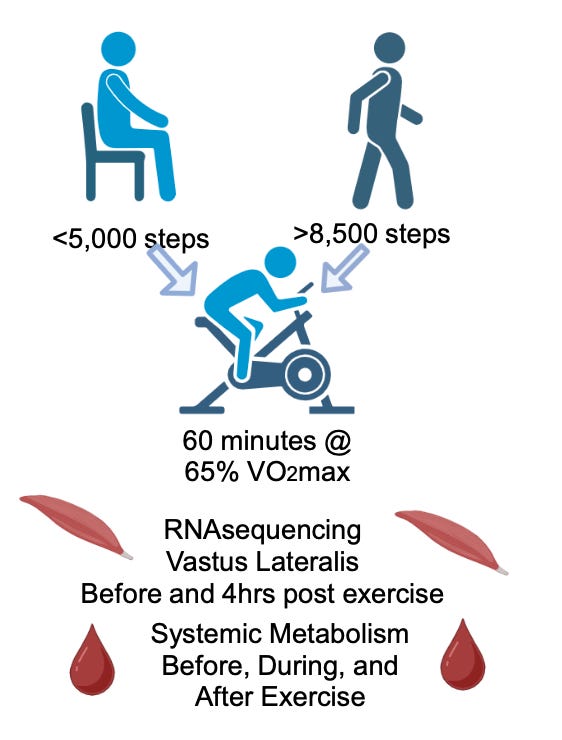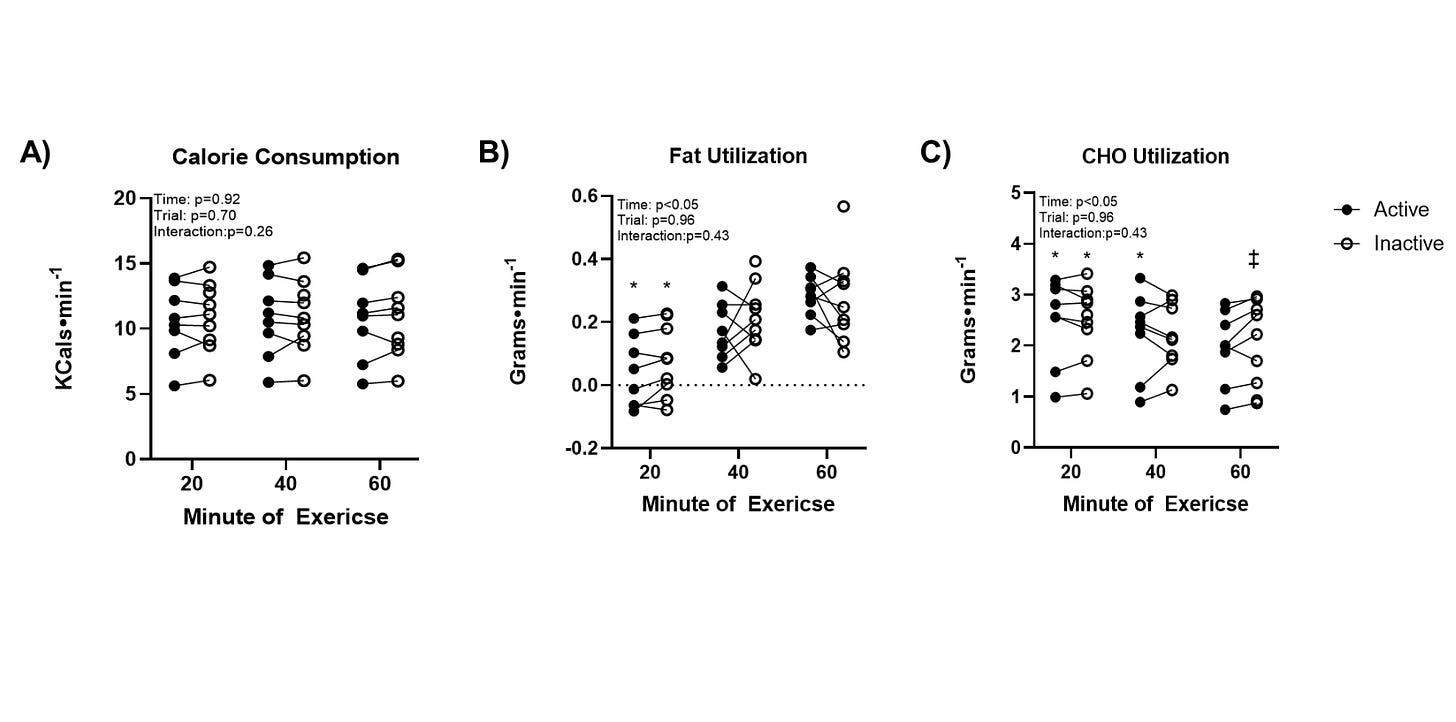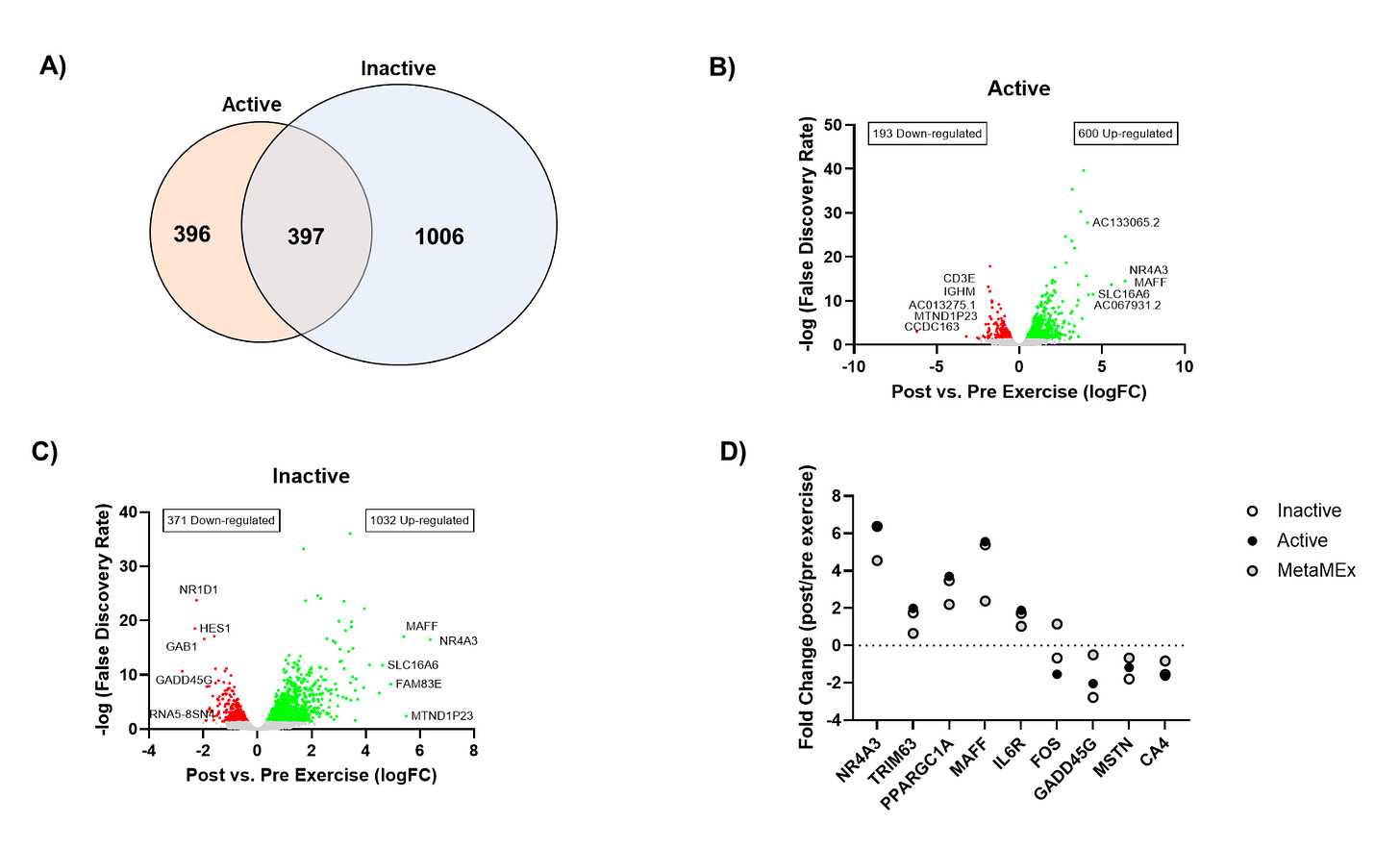Physiology Friday #295: Inactivity Changes Our Body's Response to Exercise
Could a low step count today make tomorrow's workout less effective?
Greetings!
Welcome to the Physiology Friday newsletter.
Details about the sponsors of this newsletter, including Ketone-IQ, Create creatine, and my book “VO2 Max Essentials,” can be found at the end of the post. You can find more products I’m affiliated with on my website.
It’s common for athletes to taper before a big event or competition. They reduce their exercise volume and/or intensity for a few days to weeks in the hopes that their body will feel well-rested and perform optimally when it matters.
Tapering works.
But when it comes to training for aerobic fitness, strength, or general health, tapering may actually be counterproductive.
In the last decade, a concept has emerged in exercise science research known as “exercise resistance” (no, it’s not an aversion to exercise).
Exercise resistance refers to the idea that certain habits make our body less responsive to the normal, adaptive process that occurs when we work out.
Typically, a single bout of exercise leads to the upregulation or downregulation of hundreds to thousands of genes, resulting in enhanced fat burning and insulin sensitivity, as well as increased muscle protein synthesis. All of this still happens during exercise resistance… just to a lesser extent. Exercise becomes less effective.
What causes exercise resistance?
The biggest culprit is inactivity. Being sedentary is, in and of itself, harmful. In fact, it’s one of the biggest risk factors for diabetes, heart disease, and a host of other ailments (“sitting is the new smoking”, remember?)
However, it turns out that being sedentary—even in the context of adequate physical activity—can meaningfully reshape how the body responds to exercise. Your background physical activity (what you do when you’re not exercising) matters just as much as the exercise itself.
Defining sedentary is hard to do, but researchers have typically used a step count “threshold” of 5,000 steps per day. This is typically sufficient to cause exercise resistance in otherwise healthy young adults.
The metabolic and skeletal muscle changes that occur (or don’t) during exercise resistance are still being ironed out, but a new study provides some of the deepest insight into the phenomenon by asking whether a single low‑activity day changes how your body and muscles respond to exercise the next morning.1
The short answer: your workout still “works,” but you burn a bit more sugar, carry higher triglycerides, and flip a different set of genes on in your muscles after a day on the couch.
Researchers recruited 9 healthy, recreationally active young adults (7 men and 2 women) who took part in two separate conditions.
Both conditions involved a 60-minute workout—they rode a stationary bike at an intensity of 65% of their VO2 max. Blood draws and muscle biopsies were taken before, during, and up to 4 hours after exercise.
What differed was what the participants did the day before the exercise session:
One day was a forced inactive day—they dropped their step count to <5,000 by avoiding running, walks longer than 10 minutes, and minimizing stairs. Average step count on this day ended up being just ~3,600.
Another day was the active day—participants were told to take more than 8,500 steps, and ended up averaging around 11,000 steps on this day when all was said and done. That’s more than 4x as many steps on the active day compared to the inactive day.
Inactivity alters fuel burning during exercise
Let’s first talk about what didn’t change. During exercise, oxygen uptake, heart rate, energy expenditure, and workload were the same after the active day and the inactive day (both exercise sessions burned about 650 calories). So were blood levels of HDL, total, and LDL cholesterol; lactate; and free fatty acids.
Effort-wise (physiologically speaking), exercise looked the same whether the participants spent the prior day being active or sedentary.
The big finding was that inactivity subtly shaped fuel utilization during exercise. At the end of exercise, carbohydrate oxidation was higher and fat oxidation was lower after the inactive day. The same workout burned a bit less glucose and relatively less fat by the end of the session (this was determined using something called the respiratory exchange ratio or RER, which estimates what fuel your body is using based on the gases—oxygen and carbon dioxide—you breathe out. Higher RER = more carbs being burned, while a lower RER = more fat being burned).
Lower fat burning during exercise was mirrored by the finding that triglycerides in the blood were higher throughout exercise and the 4-hour recovery after the inactive day, compared to the active day.
Inactivity alters the genomic response to exercise
The novelty of this study wasn’t the measurements of metabolic factors, but rather, the muscle proteomic and genomic responses at rest and after exercise.
At rest (before exercise), only 9 genes were different after one low-step day, including two genes known as APLN and PDP1 (linked to metabolism and muscle contraction signaling) and TNFRSF12A (involved in muscle growth and remodeling).
But after exercise, the gene response was bigger following the inactive day: More than 1,400 genes changed after the inactive day compared to just 793 after the active day (397 genes were shared). Among the genes unique to the inactive day (the “extra” pathways that changed) were several linked to cell senescence, growth hormone and immune cell signaling, and even cancer. The general trend seemed to be a larger genetic response after a day of inactivity that was more “immune/inflammation-tinted.”
What’s the mechanism?
What is going on “under the hood” that might explain the altered metabolic and molecular response to inactivity? The authors propose a few things:
On the inactive day, the participants took around 7,500 fewer steps and almost certainly did less non-exercise activity, possibly burning up to 250 calories fewer on that day compared to the high-step-count day. The same food (diet was controlled for), combined with fewer daily calories burned, likely means more energy was stored, including more muscle glycogen. More muscle glycogen means more carb burning during exercise and a different metabolic and signaling response. It’s well known that exercising with lower muscle glycogen leads to different adaptations than training with a “full gas tank.”
This fits with the data showing more carbs burned at the end of exercise and a broader gene response in pathways related to growth, inflammation, and metabolism after the inactive day.
The other explanation has to do with an enzyme called lipoprotein lipase or LPL. LPL is crucial for breaking down triglyceride-rich particles in the blood so they can be used for energy. Prior literature shows that inactivity can quickly suppress LPL activity, and the higher levels of triglycerides after the inactive day in this study seem to be an early them of this exercise resistance pattern.
This was a clever, tightly controlled study; however, it’s still just nine people and one kind of exercise. Think of it as “proof of concept” and not “universal law” (for now).
Regardless, I think the takeaways from this study and the other exercise resistance literature are clear and highly practical.
You should think about your physical activity as distinct from your structured exercise training. Someone who’s working out 5 days per week but is otherwise sedentary (which probably includes a majority of people working a desk job) is likely leaving some training gains on the table. Does this mean one shouldn’t allow time for rest and recovery? Of course not… that’s also crucial for adaptation and preventing injury. What it means is that sitting on the couch or at a desk all day after your workout is doing you no favors.
I also think this changes how we think about “rest days”—the goal shouldn’t be to hit zero steps, but to aim for a minimum floor of movement (~8,500 steps or more based on this study) or at least several short walks throughout the day. This is especially true if you’ve got a big workout planned for tomorrow. I’d be sure to scatter lots of low-intensity movement throughout the day rather than save your legs by not moving at all.
But we also shouldn’t catastrophize the occasional lazy day—everyone needs them, and nothing about this study suggests that being inactive makes a workout useless… just less useful than had you been active. The problem likely isn’t a single low-step day, but when low-step days become the default background to your training.
Ever since encountering the exercise resistance literature, I’ve made it a key point to add 1–2 short walks to most of my days, even those when I’ve done a heavy workout (or plan to do one in the future). I generally use 7,000 steps as my “baseline” every single day.
Subjectively, I always feel better. Maybe it’s the clearer head and fresh air. Or maybe it’s my body recognizing that movement is the default state of humans, and our body rewards us when we do it regularly.
Thanks for reading. See you next Friday.
~Brady~
The VO2 Max Essentials eBook is your comprehensive guide to aerobic fitness, how to improve it, and its importance for health, performance, and longevity. Get your copy today and use code SUBSTACK20 at checkout for a 20% discount. You can also grab the Kindle eBook, paperback, or hardcover version on Amazon.
Ketone-IQ is high-performance energy in a bottle. I use it for post-exercise recovery along with enhancing focus, mood, and cognition. Take 30% off your order.
Create is the first “modern creatine” brand. They sell a wide range of creatine monohydrate gummies—and yeah, their gummies actually contain creatine, unlike some other brands. They’re giving my audience 30% off their order this week. So stock up!









Interesting…but a nine person study? Hope it gets replicated with a larger group.
While complete inactivity is for sure bad for performance as well as overall health, I can guarantee you from my own personal experience that there is definitely a big effect of diminishing returns when it comes to daily activity level or step count.
After years of fighting RED-S and compulsive exercise disorder I had to see on my own body that doing too much is just as bad as doing too little - if not even worse; especially for long term health and the ability to exercise and be active at all...
Your recommendation of a 7 000 steps baseline sounds, however, like a very reasonable and healthy approach. For sure better than the 20-30 000 I averaged per day on top of multiple hours of running and/or cycling! 😅
As a rule of thumb I try to not go beyond two short walks per day or one slightly longer one. Not having a car and living in Europe where you don't need one for daily chores, I try to take the bike for everything else to not overdo it with the walking and pounding.